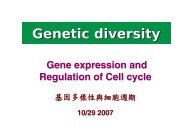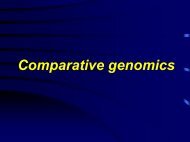Advertisement
Advertisement
Advertisement
- No tags were found...
You also want an ePaper? Increase the reach of your titles
YUMPU automatically turns print PDFs into web optimized ePapers that Google loves.
Q3: Which factors are mostimportant to achievinghigh genotypingaccuracy?(continued from p.11)This depends very much on the method being used.We found that the GOOD assay, which separatesalleles based on their molecular weight, is highlyaccurate. However, as it comprises many steps, thereis a loss in repeatability. In fluorescent methods, thekey factor is the design of the primers/probes.Depending on the method, this may be done by themanufacturer, in which case there is little controlover design; in certain cases, the researcher maydesign their own primers/probes, for example forTaqMan, using PrimerExpress.— Heather McKhannA highly accurate genotyping method together withcareful research about the gene and SNPs to beinvestigated to avoid, for example, multiplesequence variation sites and genotyping ofpseudogenes. Of course, highly skilled and carefultechnicians are crucial.— Louise NordforsAutomation in all processes. In DNA extraction,working in 96-well or 384-well formats and withrobots preparing the PCRs and the following postprocess.— Jose Luis RoyoBasically, we believe that the more factors taken intoconsideration for improving accuracy, the higheraccuracy will be achieved. However, too manyfactors may lead to difficulties in sample handlingand automation. Right now, we prefer ASO- (allelespecificoligonucleotides) and LSO- (locus-specificoligonucleotides) based hybridization, primerextension and ligation.What's more, primer design algorithms, oligosynthesis protocols, redundancy of reactions, andquality of DNA samples are also very important inensuring maximum accuracy in SNP genotypingmethods.— Huanming YangList of resourcesOur panel of experts referred to a number publications,which we’ve compiled in the list below.PublicationsChen X, Levine L, Kwok PY (1999) Fluorescencepolarization in homogeneous nucleic acid analysis.Genome Res. 9:492-498.Giancola S, McKhann HI, Bérard A, et al. (2006)High throughput genotyping in plants:comparison of three current technologies. TheorAppl Genet. 112(6):1115-1124Landegren U, Kaiser R, Sanders J, Hood L (1988) Aligase-mediated gene detection technique.Science. 241:1077-1080.Macdonald SJ, Pastinen T, Genissel A, et al. (2005)A low-cost open-source SNP genotypingplatform for association mapping applications.Genome Biol. 6:R105.Matsuzaki H, Dong S, Loi H, et al. (2004)Genotyping over 100,000 SNPs on a pairof oligonucleotide arrays.Nat Methods.1:109-11.Sauer S, Lechner D, Berlin K, et al. (2000) A novelprocedure for efficient genotyping of singlenucleotide polymorphisms.Nucleic Acids Res. 28:E13Shen R, Fan JB, Campbell D, et al. (2005) HighthroughputSNP genotyping on universalbead arrays. Mutat Res. 573:70-82.Syvänen AC (2001) Accessing genetic variation:genotyping single nucleotide polymorphisms.Nat Rev Genet 2:930-942.AcknowledgmentsMany thanks to Aurélie Bérard of INRA for advisingon the answers submitted by Heather McKhann.18 SNP Genotyping Tech Guide Genome Technology






